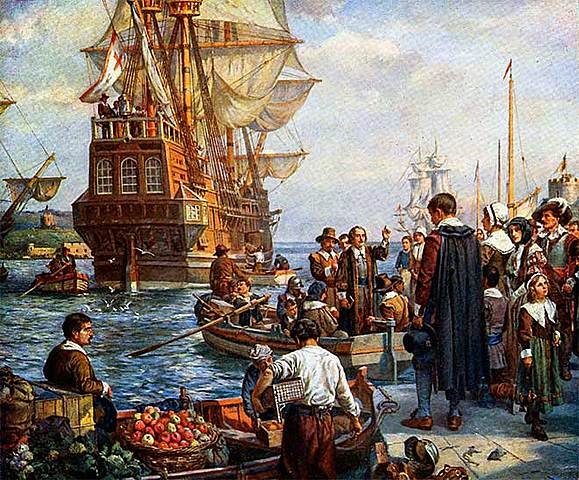Introduction and historical context
A hundred years ago, at the beginning of the 20th century, international trade was in a very different stage compared to today. At that time, maritime and rail transport dominated trade routes, facilitating the exchange of goods primarily among the major economic powers. However, this flourishing trade was drastically interrupted by a series of global events that profoundly marked the 20th century.
The First World War (1914–1918) and the Great Depression of 1929 caused a significant contraction in international trade. Protectionist policies and tariff barriers implemented during this period led to a sharp decline in trade flows. The situation worsened with the outbreak of the Second World War (1939–1945), which caused massive infrastructure destruction and a reduction in productive capacity in many regions of the world.
After World War II, efforts for reconstruction began, and initiatives were proposed to revitalize global trade. The creation of institutions such as the International Monetary Fund (IMF) and the General Agreement on Tariffs and Trade (GATT), the precursor to the World Trade Organization (WTO), were crucial in establishing a regulatory framework that promoted trade liberalization and the reduction of tariff barriers. Multilateral agreements were encouraged to facilitate greater economic integration between countries.
In the final decades of the 20th century and early 21st century, international trade experienced an unprecedented expansion. Technological advances in transport and communication, along with globalization, have enabled a deeper and more complex economic interconnection. This has transformed supply chains, allowing goods and services to be produced and distributed globally with previously unimaginable efficiency and speed.
Importance of International Trade in the Modern World
International trade has established itself as a crucial driver of global economic growth in our contemporary world. Its importance lies in its ability to connect markets and facilitate the exchange of goods and services between countries, thereby promoting efficiency and innovation. In fact, economies integrated through trade tend to grow faster and be more resilient to domestic economic crises.
One of the most significant contributions of international trade is the reduction of global poverty. According to the World Bank, trade has been a key factor in the decline of extreme poverty in recent decades, by providing access to broader markets and employment opportunities to millions in developing countries. Trade liberalization has particularly benefited regions such as East Asia and the Pacific, where extreme poverty dropped from 61% in 1990 to 4% in 2015.
Moreover, international trade fosters global cooperation and economic integration, establishing ties between nations that go beyond the commercial sphere. Organizations such as the World Trade Organization (WTO) and agreements like the North American Free Trade Agreement (NAFTA) or the more recent Trans-Pacific Partnership (TPP) exemplify efforts to create a more stable and predictable framework for international trade. These agreements not only facilitate trade but also promote labor, environmental, and human rights standards.
Recent statistics show that the value of global merchandise trade reached $19.48 trillion in 2021, a significant increase compared to previous decades. This expansion is a testament to the fundamental role of international trade in the current global economy, highlighting its relevance in improving quality of life and creating opportunities worldwide.
First Stage (1920–1945)
The period between 1920 and 1945 was marked by significant challenges for international trade, dominated by rising protectionism and tariff barriers imposed by nations in response to economic instability. World War I had left a devastated global economy, with nations seeking to rebuild their industries and protect their domestic markets through protectionist policies. These measures, in turn, limited the flow of goods and capital between countries, exacerbating economic and political tensions.

The Great Depression, which began in 1929, profoundly impacted global trade. The dramatic drop in prices and demand for goods worldwide led to a massive reduction in international trade. Governments increased tariff barriers in hopes of shielding their economies from foreign competition. A notable example was the U.S. Hawley-Smoot Tariff Act of 1930, which raised tariffs to unprecedented levels, prompting retaliatory trade measures from other nations and a further contraction of global trade.
In an attempt to promote international cooperation and stabilize the global economy, the League of Nations was created in 1920. However, this institution failed to achieve its goal of preventing protectionist practices and coordinating coherent trade policies among its members. The lack of effective authority and the absence of some key nations hindered its capacity to influence trade policies. Nonetheless, it represented one of the first efforts toward global economic governance.
The policies of the era reflected a trend toward economic isolationism, which, in turn, set the stage for the conflicts that would lead to World War II. This period provides a critical look at how protectionist policies and the lack of international cooperation can have devastating effects on global trade and economic stability.
Second Stage (1945–1970)
After World War II, the world was in a state of reconstruction and renewal. With the emergence of the Bretton Woods system in 1944, the foundations for a stable international economic order were laid. This system, which included the creation of the International Monetary Fund (IMF) and the World Bank, aimed to foster global economic cooperation and prevent the kinds of crises that had contributed to the previous world conflict.

The establishment of the General Agreement on Tariffs and Trade (GATT) in 1947 was one of the most significant milestones of this second stage. GATT provided a multilateral framework to regulate and facilitate international trade by reducing tariffs and other trade barriers. This agreement not only promoted free trade but also spurred unprecedented economic growth in the subsequent decades.
In this context, the Marshall Plan played a crucial role in Europe’s reconstruction. Implemented in 1948, the Marshall Plan provided massive economic aid to several war-torn European countries. This effort not only accelerated Europe’s economic recovery but also fostered significant trade expansion. The revitalized economies of Western Europe quickly became engines of global growth, increasing both industrial production and consumption, which in turn boosted interregional trade flows.
The impact of these initiatives was profound. The strengthening of international institutions and the promotion of open economic policies created a solid foundation for modern international trade. Economic interdependence among nations intensified, laying the groundwork for a more integrated and collaborative global economy. The principles and agreements established during this stage were fundamental to the sustained development of international trade in the second half of the 20th century.
Third Stage (1970–2000)
The third stage in the evolution of international trade, spanning from 1970 to 2000, was marked by significant changes in the global economic system. The collapse of the Bretton Woods system in 1971 ushered in an era of floating exchange rates, replacing the fixed-rate regime that had dominated since the end of World War II. This transition enabled greater economic flexibility and facilitated an increase in trade transactions.
During this period, trade liberalization became a global priority. The creation of the World Trade Organization (WTO) in 1995 consolidated previous GATT agreements. The WTO promoted the elimination of trade barriers, encouraging freer and fairer trade among nations. Through negotiation rounds such as the Uruguay Round (1986–1994), important progress was made in tariff reductions and subsidy eliminations, stimulating global trade growth.
Increasing globalization and technological advances enabled unprecedented economic integration, referred to as the «third globalization.» Emerging powers, especially in Asia, began playing crucial roles in international trade. China, in particular, implemented significant economic reforms during this period, including the opening and modernization policies initiated in 1978 under Deng Xiaoping. These reforms laid the foundation for China’s spectacular economic growth in the following decades.
In addition to China, Asian economies like South Korea, Taiwan, and Singapore also underwent notable economic transformations that positioned them as key players in global trade. For example, South Korea joined the club of industrialized nations after a series of economic reforms and trade agreements that diversified its export-oriented economy.
In summary, the third stage of international trade is characterized by trade liberalization, the collapse of the Bretton Woods system, and the rise of emerging economies that reshaped the global trade landscape. The emergence of new economic powers and the creation of the WTO were decisive factors in the transformation and globalization of trade flows at the end of the 20th century.
Fourth Stage (2000–2023)
The fourth stage of international trade, from 2000 to 2023, has witnessed significant transformations driven by digital globalization. Digitalization has facilitated instant communication and information exchange, enabling market integration and the expansion of global value chains. New technologies, such as e-commerce and digital platforms, have acted as catalysts allowing businesses and consumers to access products and services from around the world more easily.
Globalization has also increased the trade of services, which has grown at a faster pace than the trade of physical goods. Sectors such as finance, education, and tourism have seen significant increases in cross-border trade thanks to improvements in information and communication technologies. This shift has enabled companies and professionals to offer services globally, expanding their markets and reaching a broader customer base.
Despite these advances, the fourth stage has also faced major challenges. The rise of protectionism and trade wars, especially among the world’s largest economies, has created uncertainty in global markets. Tariff policies and non-tariff barriers have affected supply chains and disrupted trade flows. Moreover, the COVID-19 pandemic had a profound impact on international trade, disrupting supply chains, reducing global demand, and hindering the movement of goods and people.

These recent challenges have forced international trade actors to adapt quickly and rethink their trade strategies. This has led to a trend toward diversification of suppliers and markets, as well as a greater emphasis on resilience and sustainability in supply chains. As the world recovers from the pandemic, future trends point toward increased digital integration and adaptation to new geopolitical realities. Adaptability and innovation will remain essential to navigate an evolving trade environment.
Key Contributions of International Trade to Economic Growth
International trade has been a crucial driver of global economic growth over the past century. It has enabled countries to specialize in producing goods and services in which they have a comparative advantage, thus improving production efficiency and optimizing resource use. This phenomenon has facilitated greater product variety in markets, benefiting both consumers and producers.
A clear example of this specialization is the automotive industry. Japan, with its efficient production chain and high quality, has established itself as a global leader in car manufacturing. This has not only boosted its domestic economy but also generated employment and development in other countries involved in its supply chain.
Moreover, international trade has been fundamental in reducing poverty in many developing nations. Market openness has allowed these countries to access advanced technologies and foreign capital, fostering industrialization and improving living conditions. For example, the economic growth in China and Vietnam has lifted millions out of extreme poverty, thanks in part to their export-oriented trade policies.
International competition also drives innovation and competitiveness. Companies around the world are constantly introducing new products and improvements to maintain their market share, resulting in benefits for consumers. A World Bank study found that countries with open economies are more likely to be innovative and efficient in their production processes.
Finally, international trade has promoted global economic interdependence, strengthening ties between countries and reducing the likelihood of conflicts. The globalization of supply chains has created a complex network of economic relationships, where stability and cooperation are fundamental to collective well-being.
Challenges and Criticisms of International Trade
International trade has played a crucial role in global economic growth, increasing prosperity and facilitating interconnection among nations. However, this phenomenon has not been without challenges and criticisms, which highlight economic inequality, environmental impact, and the resurgence of protectionism and economic nationalism.
One of the most significant criticisms of international trade is the growing economic inequality both among and within nations. Despite the creation of wealth, not all regions and sectors of society have benefited equally. Countries and companies with more resources and innovation capacity tend to reap greater rewards, while developing nations struggle to compete on equal terms. This situation has exacerbated economic disparities, generating social and political tensions.
Environmental impact is another critical area where international trade has faced criticism. The expansion of production and international transport of goods has significantly increased greenhouse gas emissions. Additionally, continued exploitation of natural resources can lead to environmental degradation and loss of biodiversity. In response to these issues, calls have been made for greater sustainability within the framework of international trade, promoting eco-friendly practices and reducing environmental harm.
Meanwhile, the resurgence of protectionism and economic nationalism has emerged as a reaction to internal economic problems and perceived injustices in global markets. Protectionist policies, such as tariffs and trade barriers, aim to protect domestic industries but can lead to trade wars and decreased international cooperation, negatively affecting interdependent economies.
To address these challenges, international responses have included climate change agreements, such as the Paris Agreement, and the promotion of economic and social justice through institutions like the World Trade Organization (WTO). These measures seek to balance the benefits of international trade with more equitable and sustainable practices, aiming to ensure more inclusive global development that respects the environment.
Future Impact of International Trade
International trade is undergoing a profound and ongoing transformation, driven primarily by technological advances such as artificial intelligence (AI) and digital commerce. These developments are redefining trade dynamics, enabling faster, more efficient, and secure transactions. Artificial intelligence, for example, is revolutionizing global supply chains through more accurate demand forecasting systems, reduced operational costs, and optimized trade routes.
Trade digitalization is also facilitating the entry of small and medium-sized enterprises (SMEs) into international markets, democratizing access and strengthening trade globalization. Through e-commerce platforms, SMEs can reach a global audience without traditional cost and logistics barriers. This trend is contributing to a more diversified and resilient international trade landscape.
Another critical aspect of the evolution of international trade is the growing importance of sustainable trade practices. Companies are increasingly aware of the need to reduce their carbon footprint and adopt more environmentally friendly business models. This is reflected in initiatives such as reducing greenhouse gas emissions in freight transport, using renewable energy, and implementing circular economy practices. Adapting to these environmental and social challenges is essential not only to comply with international regulations but also to respond to consumers’ growing demand for environmentally conscious products.
Finally, the rise of emerging economic powers such as China and India is reshaping the global trade landscape. These economies are playing an increasingly central role in international trade relations, influencing both trade policies and global supply chains. As their influence grows, we are likely to witness a shift in global economic power centers and new strategies of cooperation and competition on the world stage.
Projections indicate an increasingly interconnected future for international trade, with a focus on sustainability and technological integration. Possible scenarios include more digitalized and automated trade, greener supply chains, and equitable participation from various emerging economies ready to play key roles in shaping 21st-century trade.
References
- Ricardo, David. On the Principles of Political Economy and Taxation. John Murray, 1817.
- Samuelson, Paul A., and Wolfgang Stolper. «Protection and Real Wages.» The Review of Economic Studies, 1941.
- Bhagwati, Jagdish. In Defense of Globalization. Oxford University Press, 2004.
- Krugman, Paul. Rethinking International Trade. MIT Press, 1990.
- Sachs, Jeffrey D. The End of Poverty: Economic Possibilities for Our Time. Penguin Press, 2005.
- Baldwin, Richard. The Great Convergence: Information Technology and the New Globalization. Belknap Press, 2016.
- Rodrik, Dani. The Globalization Paradox: Democracy and the Future of the World Economy. W.W. Norton & Company, 2011.



